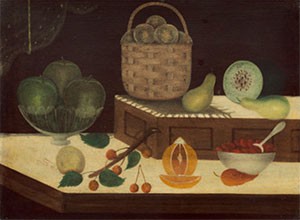Little is known about the painter of the National Gallery of Art’s nineteenth-century American Still Life of Fruit, yet the composition suggests its creator’s delight in simple forms: apples, cherries, a melon, and citrus reduced to nearly perfect circles; the table and fringed mat simplified to parallelograms that accentuate their edges and surfaces. The artist has also playfully arranged the shapes within the composition: a trio of apples in the glass compote echoes the fruit neatly piled in the basket, and even this pyramidal design appears abstractly in the double-stemmed cherries nearest the viewer and the adjacent cut orange. Similar resonances occur in the complementary diagonals of the branch and spoon handle, and among the leaves and pears that share lively tapered, curved shapes. Overall, the painting is permeated with a sense of delicacy, not least in the pristine contours, the careful shading, and the grain of the wood employed to heighten the illusion of the basket.
Early American modernists especially admired folk paintings such as Still Life of Fruit (common throughout the United States in the nineteenth century) for their formal clarity and domestic provenance. Painter and photographer Charles Sheeler, for example, saw a simplicity and directness of vision in folk art that he ascribed to the American national character. He and his fellow modernists consequently viewed objects as disparate as Pennsylvania German pottery, New Mexican santos, Shaker furniture, and New England limner portraits as part of a cultural repository from which they could draw in their own art. With others like Hamilton Easter Field and Yasuo Kuniyoshi, Sheeler became an avid collector of American vernacular furniture and folk art. Through their connections with Juliana Force at the Whitney Studio Club, an exhibition of folk art titled Early American Art opened in 1924. This show prompted critics to propose a continuous relationship between folk art—often called “primitive” or “naïve”—and modern art, a relationship that would be explicitly articulated in the 1930s.
Elaine Yau
Corn, Wanda. The Great American Thing: Modern Art and National Identity, 1915–1935. Berkeley: University of California Press, 1999.
Quimby, Ian M. G., and Scott T. Swank, eds. Perspectives on American Folk Art. Henry Francis du Pont Winterthur Museum, with E. P. Dutton, New York, 1980.
